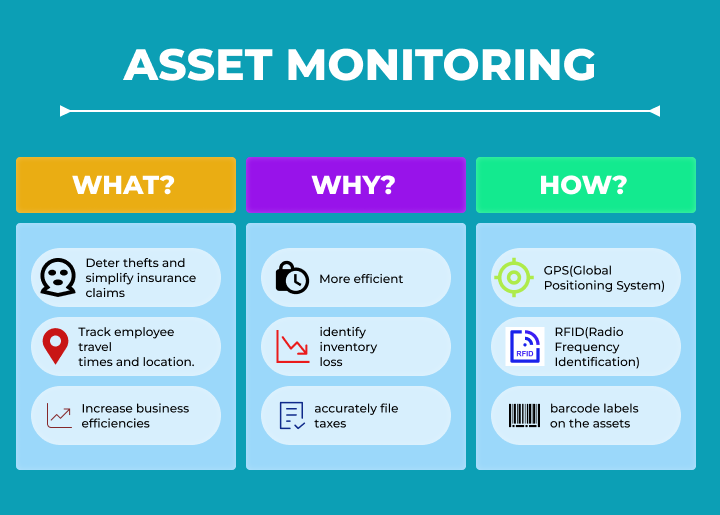Asset monitoring involves remotely tracking physical assets using specialized software and hardware. IoT-based asset monitoring solutions provide real-time information on an asset’s status, location, and name, helping managers schedule maintenance and receive alerts about failures. This technology is used in various industries, such as construction, logistics, mining, healthcare, and manufacturing.

Benefits of Asset Monitoring
1. Asset life extension: Asset monitoring software uses IoT sensors to track an asset’s condition, location, and performance, allowing managers to detect any issues and extend its lifespan.
2. Theft prevention: High-value assets need to be monitored to prevent theft, and asset monitoring solutions enhance visibility by providing accurate location details.
3. Employee behavior tracking: Asset monitoring systems can track employee behavior such as travel times, geographic locations, and driving styles.
4. Asset handling control: This feature ensures that employees follow proper protocols while handling high-value assets. If not, a manager alert is triggered.
5. Maintenance scheduling and tracking: Asset monitoring software can help schedule maintenance based on check-up times or performance metrics like mileage or service life. E-mail or SMS notifications can be used as reminders.
6. Asset failure prediction: Timely preventive action can lower production and asset maintenance costs and improve asset efficiency. Asset monitoring solutions can measure asset KPIs, analyze operation patterns, detect anomalies, and predict equipment failure. This information is useful in scheduling preventive maintenance and reducing unplanned downtime.
7. Ticketing system: Asset monitoring software can have ticketing capabilities to manage asset-related issues that are automatically identified or reported by staff. They are recorded, assigned to an appropriate technician, and resolved following a predefined action plan.
8. Asset data analytics: Managers can produce asset reports and analyze equipment performance to reduce unplanned downtime, optimize work and staff schedules, and more.
Asset Monitoring Technologies: A Review of Popular Options
Asset monitoring solutions have become increasingly popular in various industries as they enable businesses to manage, protect, and track their assets remotely. In this article, we provide an overview of the most commonly used technologies that power modern asset monitoring solutions.
1- Barcodes/QR Codes
Barcodes and QR codes are tags affixed to an item that requires an electronic scanning device to read them. Barcodes are one-dimensional and should be scanned horizontally, while QR codes are two-dimensional and can be read from any angle and transmit more information. These technologies are used for low-volume manual scanning.
2- RFID
RFID (Radio Frequency Identification) tags are commonly used in warehousing or retail facilities to monitor large high-value assets. There are two types of RFID tags: passive and active. Passive tags have readers that transmit signals to antennas that send them back to the readers, providing near real-time asset visibility and theft protection. Active RFID systems use battery-powered tags and rely on Bluetooth beacons to broadcast and read data in real-time. These tags are more expensive than their passive counterparts but have a bigger read range.
3- WiFi
WiFi monitoring solutions use local wireless networks and radio waves to broadcast asset data from WiFi tags and keep track of assets in real-time. These systems are inexpensive and easy to install but are less secure and out of service without WiFi coverage.
4- GPS
GPS asset tracking systems use receivers that automatically collect asset data transmitted by satellites. They are great for outdoor tracking in open terrain but are less effective in areas with a lot of tall buildings, forested, and enclosed areas. GPS technology provides accurate location data and is widely used for tracking vehicles and high-value assets stored outdoors in remote areas.
Conclusion
Asset monitoring solutions can be tailored to meet specific requirements and track different types of assets. If you need help choosing the most suitable technologies and implementing a tailored asset-tracking solution for your business, Etelligens can help. Contact us to learn more.